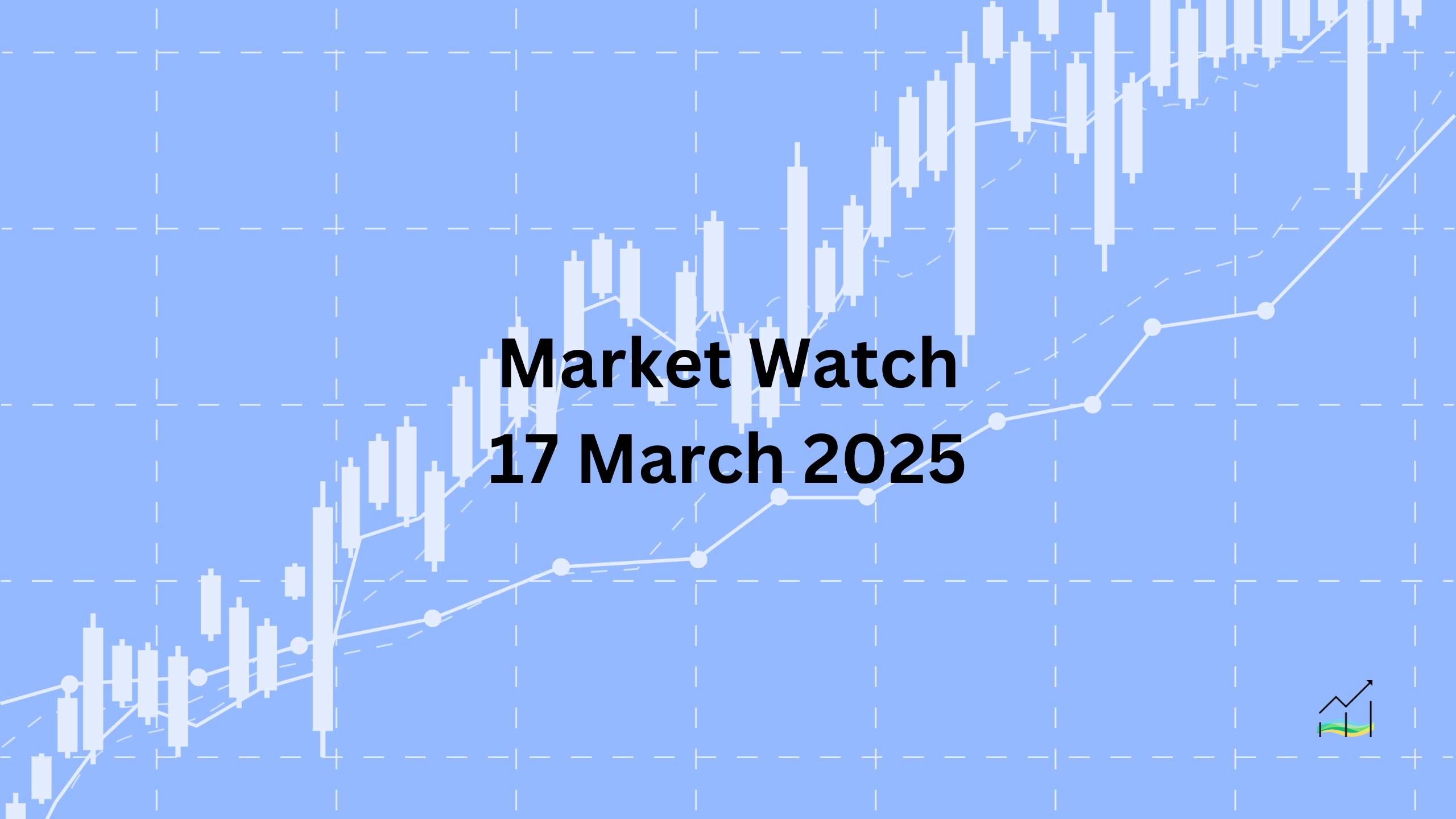17/03/2025 Market Watch

U.S. Dollar Opens Quietly Amid Central Bank Meetings
The US dollar has begun this week on a subdued note, reflecting cautious investor sentiment ahead of key economic events. Four major central banks from G10 economies are set to meet this week, alongside important US economic data expected to highlight the resilience of the US economy, despite recent pessimism from the Atlanta Federal Reserve. Additionally, former President Trump has reiterated threats of reciprocal and sector-specific tariffs, anticipated to be detailed on April 2, contributing to market uncertainty.
In currency markets, the US dollar shows mild softness amid consolidation, while emerging market currencies present a mixed picture. Notably, the People's Bank of China (PBOC) significantly reduced the dollar’s reference rate by 0.07%, marking its lowest level in four months, sending a clear message to markets. However, China's recent measures aimed at boosting domestic consumption lacked sufficient detail, causing limited enthusiasm among investors.
US equity markets face renewed pressure after Treasury Secretary Bessent described recent sharp declines in stocks as a "healthy correction," unintentionally prompting additional selling. Futures for major US indexes are currently down around 0.5%, partially reversing gains from the end of last week. Conversely, Asia-Pacific markets showed strength, with mainland Chinese stocks seeing modest gains. European markets are also optimistic; the Stoxx 600 Index is up approximately 0.5%, marking its third increase over the last four sessions.
Bond markets in Europe reflect cautious sentiment, with 10-year government bond yields falling by 5-7 basis points. Investors are particularly alert ahead of a key spending vote in Germany scheduled for tomorrow. In France, investor confidence slightly improved after Fitch reaffirmed France's AA- credit rating but maintained a negative outlook, narrowing its yield premium over German bonds.
Commodity markets exhibit strength amid geopolitical tensions and economic uncertainty. Gold remains strong, trading slightly below its recent record high near $3,005 per ounce. Oil prices are also elevated, with West Texas Intermediate (WTI) crude surpassing $68 per barrel for the first time since early March. This increase is largely due to escalating geopolitical risks following the US military action targeting Houthi positions in Yemen.
United States of America
Overview
The US Dollar Index remains steady after consolidating last week, holding below the 104.00 mark as sellers return on moves higher. Investors await key economic data and the Federal Reserve's insights this week, which could ease recent concerns over the economy's growth prospects. Recent pessimistic projections, such as the Atlanta Fed's -2.4% GDP forecast, have heightened market caution. Updates on these forecasts and fresh economic data will be crucial in shaping investor sentiment.
Economic Drivers
This week's market sentiment will primarily be driven by US economic data releases and insights from the Federal Reserve. Key factors include:
- Expectations for improved retail sales figures after January's decline.
- A potential rebound in housing market activity following January's significant drop.
- Anticipated steady industrial production growth reflecting a resilient economy.
Data and Events
Markets will closely watch the following important economic data releases this week:
- Retail Sales (February): Expected to rise by approximately 0.7%, recovering from a 0.9% drop in January.
- Housing Starts (February): Predicted rebound from January's near 10% decrease, partly influenced by adverse weather conditions.
- Industrial Output (February): Projected growth of 0.3%, following a solid 0.5% increase in January, signaling strength in manufacturing activity.
Price Action
The US Dollar Index remains range-bound, facing selling pressure near the 104.00 level. Investors are hesitant to drive the dollar higher until clarity emerges from upcoming economic reports and Federal Reserve assessments. Stability in economic data this week could shift sentiment positively.
Key Points:
- Dollar Index struggles to break above 104.00; downside momentum stalled near 103.25.
- Atlanta Fed's current GDP forecast at -2.4% causing investor caution; update expected today.
- Retail sales, housing starts, and industrial output data critical for market direction.
- Positive economic data could improve investor confidence and dollar outlook.
Canada
Overview
Market confidence remains subdued due to ongoing uncertainty around US-Canada trade tensions and potential Canadian political developments. Recent tariff threats by the US, combined with ambiguity surrounding Canada's new Prime Minister Mark Carney's intentions, have left businesses and traders hesitant. The Canadian dollar is trading within a defined range against the US dollar, reflecting market caution.
Economic Drivers
Key drivers shaping market sentiment this week include Canada's economic data releases and ongoing political developments:
- Continued uncertainty regarding US tariff threats and Canada's retaliatory measures.
- Speculation around Prime Minister Mark Carney potentially calling an early election, with parliament resuming on March 24.
- Upcoming inflation data, which may influence market expectations about Canada's economic outlook.
Data and Events
Investors will closely monitor Canada's economic data releases this week:
- Housing Starts (February): Provides insight into the strength of Canada’s housing market.
- Existing Home Sales (February): Reflects consumer confidence and real estate market activity.
- Portfolio Flow Report (January): Highlights investment trends into and out of Canada.
- Consumer Price Index (CPI) Report (February): Scheduled for tomorrow, this report is the most significant economic release this week, influencing monetary policy expectations.
Price Action
The US dollar remains confined within last week's trading range against the Canadian dollar, holding just above recent lows near CAD1.4350. The currency pair has not surpassed CAD1.4385 today, suggesting cautious market behavior amid unresolved economic and political uncertainties.
Key Points:
- US-Canada trade tensions continue to unsettle markets.
- Uncertainty about Prime Minister Carney's plans adds political risk.
- Canadian inflation data (February CPI) is critical for market direction.
- US dollar remains stable within a narrow trading range against CAD (CAD1.4355–CAD1.4485).
China
Overview
The US dollar continues to trade weaker against the Chinese yuan, recently hitting new yearly lows against both offshore and onshore yuan. Although currently trading near the weaker end of its four-month range, further downside seems limited, suggesting potential for the dollar to recover slightly. China's latest economic data showed signs of ongoing weakness, increasing expectations for additional government stimulus.
Economic Drivers
China's economic conditions and policies remain key drivers influencing the dollar-yuan exchange rate. Critical factors currently shaping market sentiment include:
- China’s February economic data indicating continued weakness in industrial output and retail sales compared to the previous year.
- Ongoing declines in Chinese property prices, suggesting persistent stress in the housing market.
- The People's Bank of China’s (PBOC) significant adjustment of the dollar's daily reference rate to the lowest level since November, reflecting the central bank's preference for a stronger yuan.
Data and Events
Investors are closely monitoring recent data from China, which include:
- Industrial Production & Retail Sales (February): Both figures are below last year's levels year-to-date, highlighting weak consumer spending and production growth.
- New House Prices: Fell by 0.14%, marking the steepest drop since last August.
- Existing House Prices: Declined by 0.34%, maintaining a steady downward trend.
Price Action
The US dollar remains under pressure against the yuan, recently touching new lows for 2025. However, it has remained within its established four-month trading range. Given the current economic backdrop and PBOC policy stance, markets are cautious, though the potential for a slight dollar recovery appears more favorable than further significant declines below CNH 7.20.
Key Points:
- US dollar trades near its weakest point against the yuan this year.
- Weak Chinese economic data increases likelihood of additional stimulus.
- PBOC sets dollar reference rate lower, signaling preference for stronger yuan.
- Property market stress continues, adding pressure on China’s economic outlook.
- Dollar downside appears limited; potential for recovery exists.
Europe
Overview
The euro ended last week positively, briefly climbing above $1.0910, supported by news of a political agreement in Germany among major parties—CDU/CSU, SPD, and the Greens—to move forward with a crucial fiscal initiative. Markets remain calm today, with the euro trading steadily within a narrow range. Attention this week is largely shifting to central bank meetings, slightly reducing the focus on the Eurozone.
Economic Drivers
The euro’s current stability and short-term outlook are primarily influenced by ongoing political developments in Germany and global central bank decisions. Key drivers include:
- The German government’s fiscal initiative and the political consensus among major parties.
- Market caution ahead of central bank meetings (Federal Reserve, Bank of Japan, Swiss National Bank, and Bank of England).
- Limited Eurozone economic data releases, keeping attention focused on political developments rather than economic reports.
Data and Events
While economic data releases are minimal this week, market participants will closely monitor:
- Federal Reserve Meeting: Insights into US monetary policy.
- Bank of Japan Meeting: Any shifts in Japan’s economic policy.
- Swiss National Bank Meeting: Updates on monetary policy stance.
- Bank of England Meeting: Decisions impacting the UK economy.
Price Action
Currently, the euro remains stable, trading within a tight range of approximately $1.0870 to $1.0905. Although slightly below last week's peak near $1.0950, the currency is holding well above recent lows around $1.0800, reflecting cautious optimism surrounding Germany’s fiscal developments.
Key Points:
- Euro maintains steady trading range ($1.0870–$1.0905).
- German political agreement supports euro strength.
- Central bank meetings dominate market attention this week.
- Minimal Eurozone economic data expected, highlighting political factors.
Japan
Overview
The US dollar recently strengthened against the Japanese yen, bouncing back from five-month lows recorded last week. The rebound, driven by rising US bond yields and declining Japanese rates, brought the dollar to its highest close in seven sessions. This week, markets will focus on Japan’s economic data and, more significantly, the upcoming Bank of Japan (BOJ) meeting scheduled for Wednesday.
Economic Drivers
Currency movements between the US dollar and Japanese yen this week will primarily be influenced by:
- Rising US interest rates compared to declining Japanese rates, boosting the dollar.
- Market anticipation of the BOJ’s monetary policy decision, with expectations largely favoring no immediate policy shift.
- Japanese economic indicators reflecting early-year performance.
Data and Events
Market participants will closely monitor the following key events and data from Japan:
- Tertiary Industry Index (January): Expected to confirm weak economic activity at the start of the year.
- Trade Balance (February): Likely to show an improved position from January’s deficit of JPY 2.74 trillion, partially due to seasonal trends and potentially increased exports ahead of expected US tariffs.
- Bank of Japan Meeting (March 20): Widely anticipated to maintain current monetary policy, with most economists predicting no changes until at least Q3 2025.
Price Action
The dollar is currently stable near JPY 148.65 after briefly approaching JPY 149 earlier today. Immediate resistance is expected around JPY 149.20–149.30, while a clear break above JPY 150 would signal a significant shift and could confirm the end of the dollar’s recent downward trend against the yen.
Key Points:
- Dollar rebounds from five-month lows against yen, currently near JPY 148.65.
- Rising US rates and falling Japanese rates supported dollar strength.
- Important BOJ meeting set for Wednesday; no immediate policy changes expected.
- Key resistance levels at JPY 149.20–149.30, with JPY 150 a crucial breakout level.
United Kingdom
Overview
The British pound softened slightly towards the end of last week but showed notable resilience despite unexpected negative economic data. After briefly climbing above the $1.29 mark, it has continued to hold steady, trading firmly within a narrow range ahead of important UK economic updates later this week. Investors remain cautious, awaiting signals from upcoming employment data and the Bank of England (BOE) policy meeting.
Economic Drivers
Several factors influencing sterling's performance this week include:
- The surprising contraction in UK GDP for January, highlighting potential economic vulnerabilities.
- Anticipation of upcoming UK employment data, which will offer clarity on the health of the labor market.
- Expectations surrounding the Bank of England's stance, particularly the likelihood of maintaining the base interest rate at 4.50%, amid ongoing uncertainty.
Data and Events
Market attention will be on key UK economic releases and events:
- UK Employment Data (Thursday): Will offer critical insights into employment trends and economic resilience.
- Bank of England Policy Meeting (Thursday): No policy change expected, but markets will watch closely for any hints from Governor Bailey regarding future interest rate decisions.
Price Action
Sterling remains firm, currently trading near the recent highs around $1.2960. Despite the minor retreat late last week, the currency maintained key support levels above $1.2915. Any pullbacks this week could test last week's low near $1.2860, though current momentum suggests stability ahead of upcoming economic updates.
Key Points:
- Sterling resilient despite UK's negative GDP report for January.
- Pound remains stable, holding above the crucial $1.29 level.
- Markets focused on Thursday’s UK employment data and BOE meeting.
- No change expected from BOE; interest rate likely to remain at 4.50%.
- Important support level to watch is around $1.2860 if pullbacks occur.
© 2025 SKONE Enterprise (003319453-V). All rights reserved.
The content on this site is for informational purposes only and does not constitute financial advice.


